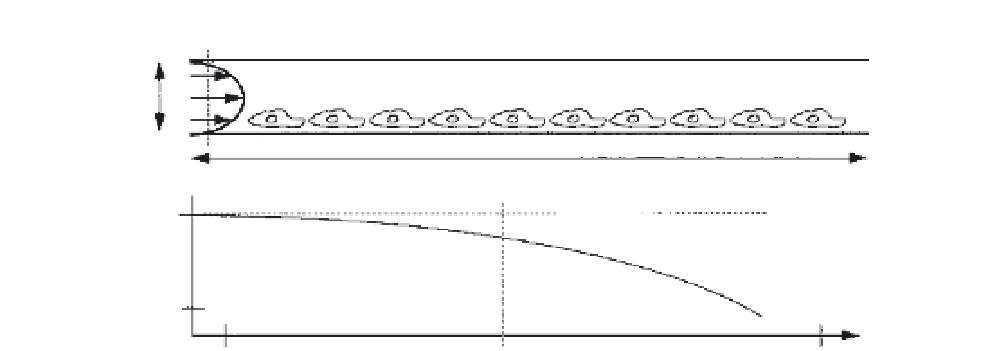Biomedical Engineering Reference
In-Depth Information
V
ave
R
L
1
fraction
removed
0.1
0.1
10
R
2
D
L
V
ave
τ
diff
~
=
=
τ
transit
For Good Removal
FIGURE 6.33
A schematic of the concentration of growth factors in a liquid that is flowing across a bed of cells
that consume it. (Bottom) The fractional removal of the growth factor as a function of the relative time constants of
lateral diffusion and transit across the cell bed. The ratio of the two is the Graetz number (Gz). If the diffusional
response time is slower than that of transit (Gz
1), then there is insufficient time for the diffusing growth factor
molecule to make good contact with the cell bed. Most of the growth factor leaves the system in the exit stream.
Conversely, if the diffusion time is much shorter than that of transit, there will be ample time for the growth factor
to make it to the cell bed. If it is rapidly consumed there, then negligible amounts will leave the system.
>
ratios will satisfy the Hele-Shaw flow approximations, in which the flow is essentially the
same over the entire width of the slit except close to the edges. The width of the slow-
flowing regions is on the order of the depth of the slit (R). Thus, if the aspect ratio is 10,
fluid will flow the same way over about 90 percent of the width of the slit. In the remaining
10 percent, the slow flow close to the wall can create microenvironments with a different
property than in the rest of the cell bed. Such nonuniformity can lead to differences in cell
growth rates and to migration of cells toward the wall. Such nonuniformity in growth
close to walls has been reported. This problem can be overcome by using radial flow con-
figurations. The example shown is for one type of a bioreactor for cell culturing. Other
configurations will have similar difficulties in achieving acceptable uniformity in condi-
tions, and careful mass and momentum transfer analyses need to be performed to guide
detailed design.
6.5 IMP
LEMENTATION OF TISSUE ENGINEERED PRO
DUCTS
6.5.1 Delivering Cellular Therapies in a Clinical Setting
In the last section, the design challenges that the tissue engineer is faced with when it
comes to scaling up microenvironments to produce cell numbers that are of clinical signifi-
cance were surveyed. These problems are only a part of the challenges that must be met in
implementing cellular therapies. In this section, some of the other problems that need to be
solved will be discussed.



